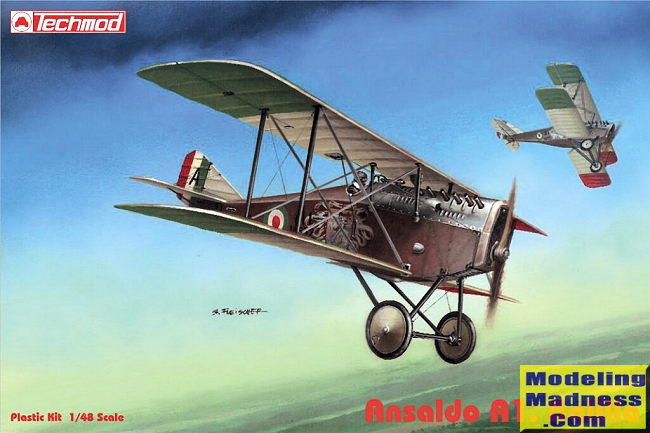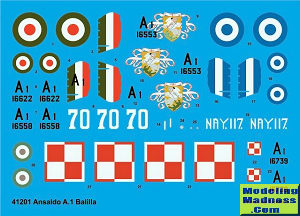
| KIT #: | 4111 |
| PRICE: | $50.00 or so |
| DECALS: | Five options |
| REVIEWER: | Rob Hart |
| NOTES: | 2024 release. Includes 3D printed parts. |

| HISTORY |
The Ansaldo A-1 Balilla was derived from the successful line of fast, but large SVA fighter and reconnaissance aircraft. Besides being smaller, the Balilla also differed from the SVAs in its use of traditional struts and bracing wires. The first prototype flew in late November of 1917 and the first production examples were ready in May of 1918. In August of the same year the aircraft was named “Balilla” after the nickname of the Italian national hero, Giovanni Battista Perasso, a boy who, in 1746, threw stones at Austrian troops pulling cannons through the streets of Genoa. The initial order was for 1600 aircraft and by August 1918 the first 100 airframes had been delivered. Most of them were assigned to training units with single examples being sent to front line units. Italian pilots considered the Balilla fast and with a good rate of climb, but not very maneuverable. They preferred to fly their familiar SPADs and Hanriots in combat which resulted in the Balilla being credited with only one aerial victory in WWI. By the end of WWI, 221 Balillas had been built in Italy.
Although unpopular with Italian pilots, the Ballila would have a successful career as an export product. Poland bought 35 planes and took out a license to build 100 more. Balillas saw combat in the 1920 Polish-Bolshevik war in the hands of the elite 7th Kosciuszko Squadron which included American volunteers. 18 Balillas were purchased by the Soviet Union and 13 were delivered to Latvia. An unknown quantity were obtained by Greece for service in the Hellenic Naval Air Service. Single machines were exported to Argentina, Mexico, Uruguay and Peru. Two Balillas were sent to the USA, where one was used by Eddie Rickenbacker to set a national speed record and the other finished third in the 1921 Pulitzer air race after installation of a Curtiss D-12 engine and a four bladed propeller.
| THE KIT |
 The
kit has 66 styrene parts, 24 3D printed parts, 2 styrene rods, and a small sheet
of clear acetate/butyrate. The 10 page instruction booklet is pictorial only,
but the 21 construction steps are clear and easy to follow. Guides for the
rigging, painting, and decal placement are also included. All control surfaces
are molded separately. The parts are crisply molded/cast and exhibit
The
kit has 66 styrene parts, 24 3D printed parts, 2 styrene rods, and a small sheet
of clear acetate/butyrate. The 10 page instruction booklet is pictorial only,
but the 21 construction steps are clear and easy to follow. Guides for the
rigging, painting, and decal placement are also included. All control surfaces
are molded separately. The parts are crisply molded/cast and exhibit very high levels of detail. The construction sequence is completely conventional
for a single engine biplane model. The cockpit and engine (a complete engine is
provided) are assembled first followed by the engine covers and radiator. After
the vertically split fuselage is closed, the empennage, landing gear, and lower
wings are attached. Finally, the upper wing is joined with the lower wings and
fuselage. Decals for three Italian, one Polish, and one Greek subject are
provided. The decals are perfectly printed and have excellent color density.
very high levels of detail. The construction sequence is completely conventional
for a single engine biplane model. The cockpit and engine (a complete engine is
provided) are assembled first followed by the engine covers and radiator. After
the vertically split fuselage is closed, the empennage, landing gear, and lower
wings are attached. Finally, the upper wing is joined with the lower wings and
fuselage. Decals for three Italian, one Polish, and one Greek subject are
provided. The decals are perfectly printed and have excellent color density.
| CONCLUSIONS |
This is a nice kit of a subject that was previously only available as a pricey and hard to find resin kit. The kit appears to be thoughtfully engineered and builder friendly. I wouldn't recommend for a first time biplane model due to the high parts count and double flying wire rigging, but experienced builders should be able to turn it into a handsome replica.
June 2024 Copyright ModelingMadness.com. All rights reserved.
No reproduction in part or in whole without express permission. If you would like your product reviewed fairly and fairly quickly, please
contact
the editor or see other details in the
Note to
Contributors.